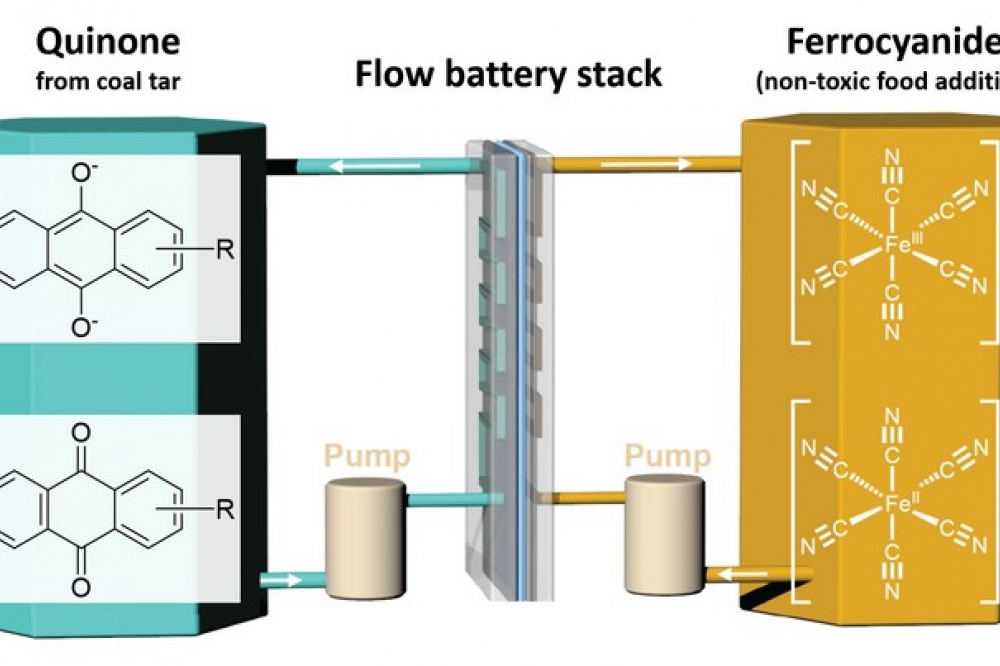Startup Quino Energy to create grid-scale battery infrastructure

Organic, water-soluble implementation may present affordable and practical approach to adoption of renewable energy sources
A new startup, Quino Energy, aims to bring to market a grid-scale energy storage solution developed by Harvard researchers to facilitate more widespread adoption of renewable energy sources.
About 12 percent of U.S. utility-scale electricity generation currently comes from wind and solar sources, which fluctuate with daily weather conditions. For wind and solar to play a greater role in the decarbonisation of the electricity grid while reliably meeting consumer demand, grid operators recognise the need to deploy energy storage systems, but these have not yet proved cost-effective at scale.
An innovative redox-flow battery now entering commercial development may help to tip the balance. Distinguished by its use of an aqueous, organic electrolyte, this flow battery was developed by Harvard materials scientists and chemists led by Michael Aziz and Roy Gordon in the Department of Chemistry and Chemical Biology.
Harvard’s Office of Technology Development (OTD) has granted Quino Energy an exclusive, worldwide license to commercialise energy storage systems using the chemistry identified by the labs, including quinone or hydroquinone compounds as the active materials in the electrolyte. Quino’s founders believe the system may offer game-changing advantages in cost, safety, stability, and power.
“The cost of wind and solar electricity has dropped so much that the greatest barrier to getting the vast majority of our electricity from these renewable sources is their intermittency. A safe, scalable, cost-effective storage medium could solve this problem,” said Aziz, a cofounder of Quino Energy.
“For grid-scale stationary storage, you want to be able to run your city through the night and when the wind isn’t blowing, without burning fossil fuels. You might go two or three days without wind in a typical weather pattern, and you’ll certainly go eight hours without sunshine, so having a discharge duration at rated power of 5 to 20 hours can be a very useful thing. That’s the sweet spot for flow batteries, where we think they can be especially competitive versus the shorter-duration lithium-ion batteries.”
“Longer-duration grid and micro-grid storage is a huge and growing opportunity, especially here in California where we’re demonstrating our prototypes,” said Eugene Beh, cofounder and CEO of Quino Energy.
In comparison to other flow batteries that rely on expensive, mined metals with limited scalability such as vanadium, the Harvard team’s organic, water-soluble implementation may present a more affordable and practical approach. Sixteen inventors, in addition to Gordon and Aziz, applied their expertise in materials science and chemical synthesis to identify, create, and test families of molecules with favourable energy density, solubility, stability, and cost of synthesis.
Most recently, publishing in Nature Chemistry in June 2022, they demonstrated a complete flow battery system that overcomes the propensity of these anthraquinone molecules to decompose over time. By subjecting the system to an occasional voltage pulse, they were able to electrochemically recompose the energy-carrying molecules, dramatically extending the lifespan of the system and thereby lowering its overall cost.
“We’ve designed and redesigned versions of these chemicals with long-term stability in mind — that is, we try to beat them up in various ways,” said Gordon,. “Our students have been very diligent in identifying molecules that can stand up to the conditions they’ll encounter in a battery in various states. Based on our findings, we’re optimistic that flow batteries filled with cheap and abundant elements have the potential to supply the future need for enhanced electricity storage.”
In addition to being selected for ongoing participation in the 2022 cohorts of the Harvard Climate Entrepreneur’s Circle, the Berkeley Haas Cleantech to Market program, and the Rice Alliance Clean Energy Accelerator, where it was named one of the Most Promising Energy Tech Startups, Quino was selected by the US Department of Energy (DOE) to receive $4.58 million in nondilutive funding from the DOE Advanced Manufacturing Office, which will support the company’s development of a scalable, continuous, and cost-effective process for the synthesis of aqueous, organic flow battery reactants.
The $4.58 million DOE grant is augmented by Quino’s recently concluded seed round: the company has raised $3.3 million from a group of investors led by ANRI, one of the most active seed/early-stage venture capital firms based in Tokyo. TechEnergy Ventures, the corporate venture capital arm of the energy transition division of Techint Group, also participated in the round.
The Harvard research enabling the innovations licensed to Quino Energy was supported by academic research grants from the DOE, National Science Foundation, and National Renewable Energy Laboratory. The Aziz lab has also received funding for experimental research in this area from the Massachusetts Clean Energy Center. As in all Harvard license agreements, the university reserves the rights of not-for-profit research institutions to continue to make and use the licensed technology for research, educational, and scholarly purposes.



































